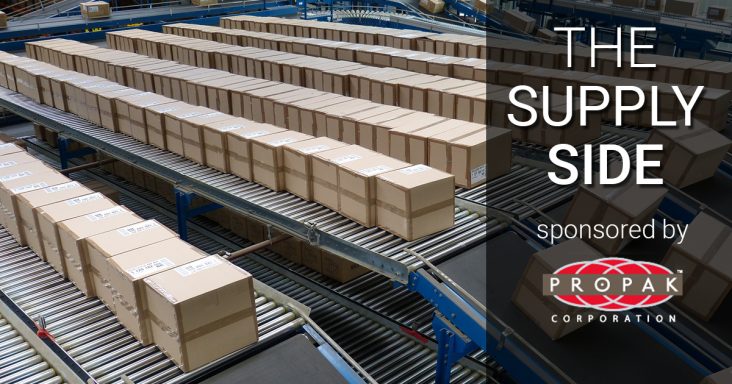The Supply Side: Global supply chain pain persists
by June 4, 2022 10:25 am 1,020 views

According to analysts with RBC Capital Markets, supply chain bottlenecks are expected to continue during 2022, despite previous forecasts of improvements in the back half of 2022. That is not good news for retailers and suppliers who import goods and raw materials.
Supply backlogs in 2021 were mainly attributed to a pandemic-induced imbalance of supply and demand as consumers chased a limited number of goods. For retailers and suppliers in 2022, it’s the same song but a different verse. Supply chain challenges are more likely from inefficient operations at major ports in Southeast Asia. Russia’s invasion of Ukraine and subsequent COVID-related shutdowns in China are to blame.
“When ships are scarce, regardless of whether due to an increasing number of vessels queuing at a port or true demand, prices see upward pressure. One fifth of the global container fleet is currently stuck in congestion at various ports,” RBC analysts noted.
They expect global freight rates to remain elevated for a protracted period as the time of turnaround (ToT) continues to rise and more ships are stuck in queue at a port. According to the report, that has also led to scheduling problems, with less than 15% of ships arriving on time.
SHIP SHORTAGE, PORT PROBLEMS
As of May 3, RBC reported 344 ships awaiting berth at the Port of Shanghai, up 34% from the prior month and resulting in a 111-day journey from a Chinese warehouse to a U.S. warehouse on average. The typical average for the trip is 37 days. The Port of Shanghai and most of the region’s 25 million residents have been under lockdown for the past month because of another COVID outbreak. RBC said the backlog and the shutdown has worsened an already tight empty container shortage.
“The ships and the containers must be available at the right time and place to prevent canceled bookings. This mismatch results in ships running below full container utilization, hence, more ships are required to move the same amount of freight,” RBC analysts noted.
In Europe, ships from China are showing up an average of four days late and causing a shortage of empty containers to take European-made goods to the Eastern U.S. ports.
“Global port congestion is worsening and becoming increasingly widespread,” Michael Tran, RBC’s head of digital intelligence strategy, said in the report.
While four days doesn’t seem that long, it is a problem because some ports in Europe have backed up thanks to the Russian invasion of Ukraine. Ships are waiting for empty containers before they leave U.S. ports, and the added time boosts overall shipping costs, Tran noted.
“The plethora of problems is having a domino-like negative compounding effect across various markets,” he said.
While the supply chain log jam in China is just part of the problem. U.S. West Coast ports are seeing the ToT stretching out to 6.9 days, compared to four days last month and an average of 3.4 days before the pandemic. RBC said ToT peaked at 8.7 days in the fall of 2021 amid the holiday shopping season.
Port delays are still a problem on the West Coast. According to Josh Gellert, president of Camerican International and contributor to the RBC report, there are growing labor issues brewing. Gellert said labor unrest and inflation are likely to weigh on the supply chain through the summer. He said some companies are switching to East Coast ports ahead of a potential West Coast port strike, which could compound other supply chain issues.
RISING COSTS, RESOLUTION ESTIMATES
Container costs have jumped from $3,000 to $30,000 in the past year. Port closures in China and delays in Europe are exacerbating the container shortage and driving prices higher, according to Josh Saffran, director of Plug & Play Tech Center in Rogers.
RBC notes that the Russian invasion of Ukraine has prompted insurance companies to raise the cost of protection coverage for ships in the Black Sea. The increased insurance rates range between 1% and 5% of the value of the ship. Before the conflict, rates were 0.25%.
After Russia’s missile cruiser “Moskva” was sunk by Ukrainian forces in the Black Sea, shipping routes were changed, causing delays in several European ports. While fuel supplies were tight before the war, prices are rising, and RBC reported that operators are passing higher costs to customers.
Normalizing consumer demand should take pressure off supply chains, but transportation bottlenecks are an ongoing issue. Morgan Stanley analysts believe quarantine and travel restrictions for key transcontinental routes may stay in place in 2022, and they don’t expect capacity increases until late 2023. The trucking industry faces labor shortages which also boost costs and increase delays.
In February, supply chain analysts at Sea-Intelligence said that the supply chain issue has no precedent. Still, experience suggested it would take eight to nine months for port and hinterland networks to recover.
Analysts at Wells Fargo said the latest supply chain challenges are likely to be present for much of 2022. China is behind the curve with its COVID protocols, and it’s uncertain when the conflict between Russia and Ukraine will ease or end. But if U.S. economic growth slows, so will the demand for goods. The supply and demand imbalance should be better in the back half of this year, but higher supply chain costs will likely persist well into 2023.
Phil Levy, the chief economist at Flexport, said supply chain improvements would require investment, technology, more ships, additional warehouses and truck drivers, easing demand, and positive port labor force incentives. He said it would take many months and perhaps years before the global supply chain returns to some sense of normalcy.
